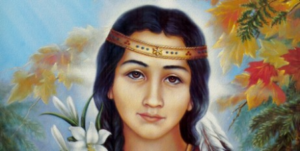By Catholic Ecology Blog
A fledgling eco-group takes wing with the intercession of a great saint
 It would be an oversight to let the day go by without mentioning one of the great patron’s of environmental protection: St. Kateri Tekakwitha (1656-1680), whose feast we celebrate today.
It would be an oversight to let the day go by without mentioning one of the great patron’s of environmental protection: St. Kateri Tekakwitha (1656-1680), whose feast we celebrate today.
I posted a reflection a few years ago on what she means for us all—and why. Today it seems appropriate to call attention to a budding environmental group that takes its name from this important woman and our sister in Christ.
The Saint Kateri Tekakwitha Conservation Center is already known by many for its collection—probably the largest of its kind—of eco-quotes from popes, saints, and theologians across the centuries.
But you’ll be hearing much more from this group as it expands its efforts into the actual world of woodland, field, and stream.
I have the honor of serving on the Board of the Saint Kateri Tekakwitha Conservation Center with great men and women. The leader among us, however, is Bill Jacobs—an environmental scientist that has been called by his faith to organize a group that keeps politics to a minimum in order to maximize piety and real-world conservation.
Jacobs said that the Center was created to promote Catholic teaching on ecology and the environment, and to work to conserve nature and protect life. He stresses that “we are a Catholic faith-based organization that believes all people are called to be co-workers with God in the care and cultivation of creation.”
Jacobs says he found inspiration for naming the organization after St. Kateri in part because of observations like those of Bishop Stanislaus Brzana of upstate New York, where Saint Kateri was born.
“Bishop Brzana tells us that ‘Kateri was a child of nature,’” Jacobs said. “’Her sainthood will raise the minds and hearts of those who love nature and work in ecology.’”
Jacobs said that 15 years ago when the Church first promoted Saint Kateri as the patroness of people who love nature and work to restore the environment, “it seemed that few people knew of this connection of Saint Kateri with conservation.
“A lot has changed since then, and in such a short time, with much more attention being given to Catholic ecology and faith. I credit the prayers of Saint Kateri for much of this change.”
The Iroquois peoples of New York State had a deep connection with the land, Jacobs said. “For centuries, the Indigenous Peoples carefully managed the fields, forests, and wildlife of their homeland. They understood the rhythms of nature, and had a transcendent sense of the natural world which included the ‘Great Spirit.’”
Saint Kateri lived at a time when the air was clean, the land and waters were rich with biodiversity, and the ecosystems were healthy, he added.
“Kateri herself would have intimately known the plants and animals around her, in a way that any botanist or biologist today would envy. She knew Jesus also, and made crosses out of sticks that she placed in the woods as she prayed. Who better to pray for us today as we work to restore God’s creation?”
And so while the work of The Saint Kateri Tekakwitha Conservation Center for now takes the form of a website and planning meetings, in time—and with the intercession of St. Tekakwitha—much will happen to protect the beauty of the land and water that Kateri loved so much.
Saint Kateri Tekakwitha, pray for us!
